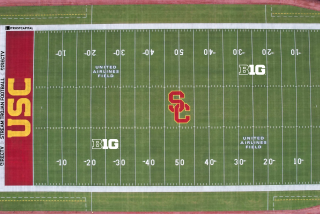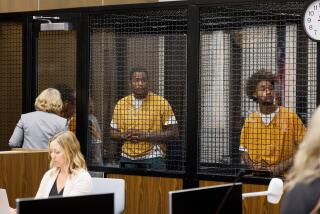Legendary Coach John McKay Dies
John McKay, the colorful and innovative coach who restored dominance to USC’s football program, making it a feared college powerhouse, died Sunday in Tampa, Fla. He was 77.
In 16 seasons at USC, McKay led the Trojans to four national championships and coached two Heisman Trophy winners. He was almost as well known for his legendary one-liners and quick retorts.
McKay, who left USC after the 1975 season to become the first coach of the NFL’s Tampa Bay Buccaneers, had been in the intensive care unit at St. Joseph’s Hospital since last month. He died of kidney failure due to complications from diabetes, Buccaneer spokesman Reggie Roberts said.
Once an electrician’s assistant in a West Virginia coal mine and later a World War II tail gunner, McKay took over the USC program in 1960 and restored it to the national prominence it had known in the 1920s and ‘30s, producing 40 first-team All-American players. Among them were Heisman Trophy winners Mike Garrett in 1965 and O.J. Simpson in 1968, the first two in a line of outstanding running backs that earned the school the nickname Tailback U.
USC was 127-40-8 under McKay, losing only 17 conference games.
Three of his Trojan teams were unbeaten, nine won Pacific 8 Conference championships and eight played in the Rose Bowl, winning five times. His 1962, 1967, 1972 and 1974 teams won college football’s national championships.
“I think he was the best evaluator of talent that I’ve ever seen,” said former USC quarterback Pat Haden, who helped McKay win the 1974 national title. “He would have some high school kid who was an All-American linebacker, and the first day he’d watch him practice and say, ‘You’re a tight end.’ Two years later, that kid was an All-American tight end.”
McKay was not nearly as successful with the expansion Buccaneers. But after losing their first 26 games under McKay, an NFL record, the Buccaneers rebounded and in only their fourth season came within one victory of playing in the Super Bowl, falling short when they lost to the Los Angeles Rams, 9-0, in the 1979 National Football Conference title game.
The Buccaneers made three playoff appearances in nine seasons under McKay, who retired after the 1984 season with a 44-88-1 record.
McKay’s players remembered him as a blunt, demanding coach who rarely brought his famous sense of humor to the practice field.
Recalled Haden, perhaps his best quarterback: “His relationship with his players wasn’t the same as it was with the press. He was tough on his players, very demanding. He expected an awful lot.”
It is the McKay humor--the briskly delivered quip, often with a cigar as his prop--that football followers will remember for as long as his powerful teams.
A sampling:
When questioned after a loss during the early days at Tampa Bay about his team’s execution, he responded, “I think it’s a good idea.”
On being asked once why Simpson carried the ball so often: “Why not? It isn’t very heavy. Besides, he doesn’t belong to a union.”
On being asked about emotion in football: “It’s overrated. My wife is emotional, but she’s a lousy football player.”
At Notre Dame, upon seeing one of his players, Mike Hunter, catch the opening kickoff, then fall down: “My God, they shot him.”
To Doug Williams, a former Grambling quarterback who was drafted by the Buccaneers in 1978, McKay was an inspiration and an innovator. At a time when an African American quarterback was an anomaly, McKay didn’t hesitate to use blacks in the sport’s most important position.
“When I was growing up watching football in Louisiana . . . my two favorite teams were the Grambling State University Tigers and the University of Southern California Trojans, and my two favorite coaches were [Grambling’s] Eddie Robinson and John McKay,” Williams said. “SC, at that time, had a black QB named Jimmy Jones. And I knew that if John McKay at that time was playing black quarterbacks, you realized that it wasn’t about color with that individual.”
At USC, McKay was an obscure assistant when he joined Coach Don Clark’s staff in 1959 after serving as an assistant coach at Oregon through most of the decade. USC had risen to national prominence under Howard Jones in the 1920s and ‘30s, but Trojan football fortunes had softened in subsequent decades.
When Clark resigned after the ’59 season, USC President Norman Topping made McKay, then 36, the head coach, giving him a one-year contract.
Recalling the promotion years later, McKay said: “Dr. Topping told me at the time, ‘Let’s see how it goes next season, then we’ll talk about extending the contract.’
“Well, we went 4-6 in 1960, and I figured that was it. On the Monday after the last game, Dr. Topping told me to meet him at Julie’s [a USC neighborhood restaurant that McKay later helped make famous] that evening. Just when we started to talk, Dan Hafner of the L.A. Times and a bunch of other sportswriters walked in.
“They ordered a round of vodkas. Then they ordered another round. Pretty soon, Dr. Topping forgot why we were there.”
McKay wasn’t long in restoring Trojan football to what it had been in 1928, 1931 and 1932, when Jones’ “Thundering Herd” teams won national titles.
His 1961 team was 4-5-1, but in 1962 the Trojans capped an 11-0 season with a memorable 42-37 victory over Wisconsin in the Rose Bowl. From then until McKay’s departure for the NFL in 1976, his teams finished among the top 10 in the Associated Press poll eight times.
His 1972 team, featuring All-American fullback Sam Cunningham, was his masterpiece, a team still considered among the best in college football history.
Perhaps the most memorable game the Trojans ever played under McKay was the USC-Notre Dame classic at the Coliseum in 1974.
Trailing at halftime, 24-6, the Trojans staged one of the greatest rallies in modern football and won, 55-24.
Years later, McKay aide Nick Pappas recalled McKay’s halftime instructions:
“He told the team: ‘Here’s what we’re going to do. We get the second-half kickoff. Anthony Davis is going to catch it, you guys are going to block, and he’s going to run it back for a touchdown, and that’ll be the end of Notre Dame.’ ”
And it was.
Davis’ 102-yard return ignited the Trojans, who, including the last play of the first half, scored 55 points in less than 17 minutes.
While at USC, McKay was seven times courted by NFL teams, most often by the Rams. In 1965, he turned down the Rams’ offer of $40,000 a year at a time when he was making $18,500 at USC.
In 1975, however, McKay finally succumbed to the NFL, accepting a 10-year, $250,000-a-year offer from the Buccaneers.
McKay, then 52, confided to a friend: “People in Tampa Bay think I’m going to go down there, coach a few years, make all that money, retire, move to Newport Beach and move into the Balboa Bay Club. And you know what? They’re absolutely right.”
As it turned out, McKay remained in Tampa in retirement, though he often spent winters in the Palm Springs area.
Born July 5, 1923, in Everettsville, W.Va., John Harvey McKay grew up in several rough-and-tumble West Virginia coal towns.
He was the third of five children born to Scotch Irish parents, John and Gertrude McKay. John McKay was a coal mine superintendent who died when McKay was 13.
McKay graduated from high school in 1941 and was offered a football scholarship by Wake Forest. He was there, enrolling, when his mother became ill. He returned home and became a coal mine electrician’s assistant.
When the Japanese attacked Pearl Harbor, McKay was earning $6.75 a day in the mines. He joined the Army Air Corps in 1942 and became a tail gunner, seeing action on B-29s in the Pacific.
Both McKay and an older brother, Jimmy (a pilot), survived the war, but youngest brother Richard was killed at 18 when his minesweeper was torpedoed in the North Atlantic.
After the war, at 23, McKay played football at Purdue before transferring in 1947 to Oregon. He became a noted running back on the 1948 and ’49 teams, but his playing career abruptly ended in the 1949 Oregon-California game when he suffered a knee injury.
McKay, 27, married and with a baby on the way, became a $2,800-a-year Oregon assistant coach in 1950.
Before leaving for USC in 1959, he had never made more than $7,500 a year as an assistant coach.
At USC, McKay’s teams were known for quick-striking firepower, largely from big, fast running backs.
He is credited with refining the I formation, with the fullback and tailback lined up directly behind the quarterback. USC tailbacks Garrett and Simpson, running out of the I, ran for a combined 6,644 yards in their Heisman careers.
“McKay didn’t invent the I; he popularized it by winning with it,” said Dave Levy, a former assistant. “In the summer of ‘62, he said one day, ‘You know, we should run plays out of this.’ So we did. And Willie Brown became the first USC tailback to run out of the I.”
McKay is survived by his wife, Corky, whom he met while a student at Oregon and married in 1950. He also is survived by their four children, Michelle, Terri, Richard and John Jr., who played college and pro football for his father.
“As great a coach as he was, he was an even better dad,” John Jr. said Sunday.
Private services will be held in Tampa. Contributions may be made to the John McKay Fund, USC Athletic Department, Heritage Hall, Los Angeles, CA 90089.
*
MORE INSIDE
Remembrance: For writers, John McKay was funny, insightful. D1
*
Times staff writer Larry Stewart contributed to this story.
More to Read
Go beyond the scoreboard
Get the latest on L.A.'s teams in the daily Sports Report newsletter.
You may occasionally receive promotional content from the Los Angeles Times.






